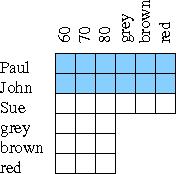Because the truthtable for this one is quite big, it is best to print only the rows that result in True.
4) Knights and Knaves:
The logician Raymond Smullyan describes an island with two kinds of people: knights and knaves. Knights always tell the truth, whereas knaves always lie. What are the following two people, knights or knaves?
A says: B is a knight.
B says: A and I are of opposite type.
Hint: you can model this as four variables: "a speaks the truth", "a lies", "b speaks the truth", "b lies".
5) A logic grid puzzle:
|
| 
|
Logic grid puzzles consist of a few clues and a grid that can be used while solving the puzzle with pen and paper. Try it!
Optional: attempt a Boolean logic solution (which may be more difficult than a solution with pen and paper). In Boolean logic each of the blue coloured squares in the grid needs to become a variable ("p60: Paul weighs 60", "p70: Paul weighs 70", etc). How many rows does a truthtable with 12 variables have?
All of the conditions (even the ones about Sue) need to be written in terms of Paul and John. The implicit conditions (someone can only have one hair colour, one weight) also need to be stated.
Since your formula won't fit on one line: you can continue it to the next line if you put a backslash at the end of the first line.
This puzzle shows the limits of Boolean logic. For more complex puzzles one needs a more higher level logic programming language (something like Prolog).
2 Intensional definition of sets
Python has a mechanism (called "list comprehension") which allows to define sets in a manner that is very close to mathematical notations. For example,
| Python | mathematical notation |
|---|---|
| ints = Set(range(1,11)) | {x | 0 < x < 11 } |
| Set([2*x for x in range(1,6)]) | {y | y = 2x; 0 < x < 6 } |
| Set([2*x for x in range(1,20) if x%3 == 0]) | {y | y = 2x; 0 < x < 20; 3 divides x } |
| Set([sqrt(x) for x in range(1,6)]) | {y | y = √x; 0 < x < 6;} |
| Set([x for x in range(1,11) for y in range(2,x) if x % y ==0]) | {x | 0 < x < 11; ∃y >1: y divides x } |
2.1 Exercises
Reminder: you'll need from sets import Set for these exercises.6) Try the examples above. Can you find a verbal description for each of the sets?
7) Define the following sets:
a) Numbers between 1 and 100 which are divisible by 2, 3 and 7.
b) Rational numbers (fractions) with a numerator between 1 and 10
and a denominator between 1 and 5. All fractions should be reduced.
c) Prime numbers below 10. (Use the set defined above and set operators.)